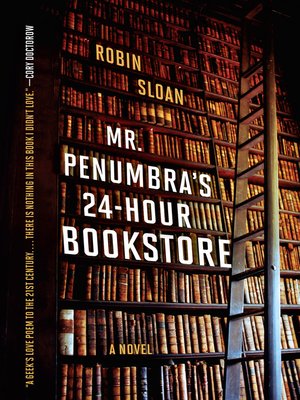 |
| The book I bought has a different cover image, but I choose this one because, this is exactly how I imagine Mr. Penumbra's bookstore looks like |
Finished this book by Robin Sloan about two weeks ago. Loved the way it is written. For me, the language and the terms used are very modern and really chic. To me, there are energy, freshness and conciseness in the way things are described in this book.
It is about a group of young people who are very determined to decode some old books in order to find out the mystery of eternal life. Their drive and determination move me and compel me to read as fast as possible to find out what happens next. Even though the ending is a bit of an anticlimax, I still think this is a good read.
Book Summary
Clay Jannon loses his job as a marketing designer and finds himself at the heart of San Francisco's most unusual bookstore. Clay works the graveyard shift, and under strict instructions from the owner—Mr. Penumbra—must catalogue each transaction with customers. However, Clay soon learns that this is no ordinary bookstore. For instance, the customers do not pay for their books, but rather, borrow them. Also, Clay must enter each customer's appearance, attitude, and aura into the customer journal. All of this information is for use by the owner.
As the mystery of Clay's job envelops him (where does Mr. Penumbra get the funds to pay him?), he decides to break the rules and conduct his own covert operation with his friends Raj, Neel, Mat, and Jad. Additionally he enlists the help of his new, amazingly talented and impressively intelligent girlfriend, Kat. Together, the team of friends uncovers the great mystery behind the “Waybacklist,” a set of encrypted books on the store's shelves.
During Clay's investigation, the troupe travels cross-country to uncover the secrets of the “Waybacklist,” not the least of which turns out to be a Knights Templar group, the Unbroken Spine. This “bibliophile cult” is not only made up of the patrons of Penumbra's bookstore, but also its parent store in Manhattan, run by Penumbra's old friend and boss, Corvina.
Via secret meetings, the Unbroken Spine seeks to decode the Founder's Puzzle, developed by Aldus (Teobaldo) Manutius, a 16th century printer and founder of the Unbroken Spine. Manutius used scholars and scribes to produce first editions of classics like Aristotle and Plato. Most importantly, though, he composed the Codex Vitae, the book of life, which contains the answer to life's greatest question: how do you live forever?
The Unbroken Spine, who works to decode the Codex Vitae, believes that once that secret is unlocked, every member of the Unbroken who has even died will live again. So, their life's work is to find the clues Manutius left hidden in those first volumes to ultimately achieve immortality. Corvina believes the only way to do this is through careful readings by the members, while Penumbra wants to take things into the 21st century by using computers to aid their way.
To help his cause, Penumbra takes Clay and his friends to “The Reading Room,” a catacomb of books where the Unbroken Spine holds their meetings. While there, Clay is able to secretly acquire and copy the only volume of the codex vitae of Manutius. From there, he uses the work of Gerritszoon, the man Manutius hired for a typeface to sustain his new printing house. Using both technology and his close reading skills, Clay ultimately unveils to the group that the tiny notches in Gettitszoon's typeface are indeed the code they've sought. He uses these to decode the Codex Vitae and a message hidden in the typeface itself: “Thank you, Teobaldo. You are my greatest friend. This has been the key to everything.”
Disappointed by this anticlimactic message, the Unbroken Spine disbands. However, Clay and Mr. Penumbra start a consulting company for other companies interested in the intersections between books and technology. Clay writes a novel about his journey to uncover the Codex Vitae, and the most important lesson he learned: only through careful work and friendship can immortality be achieved through the written word.
No comments:
Post a Comment